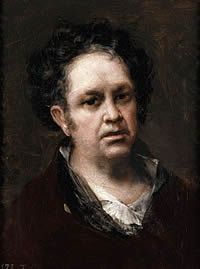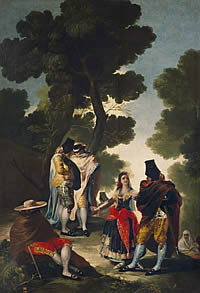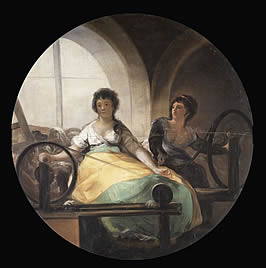Goya's Andalucían secret

Goya, Self-Portrait (1815) deliberately
presenting himself as vulnerable and
fragile, revealing the most serene and
welcoming facet of his personality
Immortalised in street names from Almería to Vélez-Málaga and throughout the Spanish Kingdom , Francisco de Goya is cemented in the lineage of world art icons. CHRIS DOVE pays tribute to the painter whose work has unearthed a surprising new secret in an Andalucían pueblo, and who's interacting today with new audiences in cyberspace.
An unexpected discovery on the majestic mountains of Mijas: Goya's Levantamiento Popular depicts a scene from the Spanish-French War of Independence , 1808-14. Specialists ascribe the work to circa 1818.
'Masterpieces from the Prado on Google Earth' allow viewers to zoom in to see intricate details of Goya's Third of May, a fascinating close-up showing the depth and reach of every brushstroke.
Right Royal connections
When Francisco José de Goya y Lucientes was discovered sketching on a wall by a local priest, his parents were advised to dedicate his young life to painting in recognition of his artistic gift. The visionary priest was so taken with the fledgling artist's genius that, aged just 12, Goya painted three works for the Fuendetodos church in his Aragón birthplace, sparking the beginnings of his long, distinguished career.

Love and jealousy: The Maja and the
Cloaked Men, or A Walk through Andalusia
(1776) is a countryside scene taken from
Goya's etchings in his 'Caprichos' series
Aged 14, he became a student of the painter José Luzán, a Neapolitan-trained mentor who taught his protégé to copy his best prints during a four-year apprenticeship. Later moving to Madrid where he studied with Anton Raphael Mengs, a popular German painter with connections to the Spanish Royal Family, Goya's artistic talents went unrecognised by the art establishment when he was denied entrance to Madrid 's Royal Academy of Fine Art on three occasions.
Unperturbed by these hiccups in his ambitions, Goya joined the art studio of brothers Francisco and Ramón Bayeu and proved to be in the right place at the right time. Not only did he marry their sister Josefa in 1773 (subsequently producing eight children), but this was the Age of Enlightenment under King Charles III, whose open support for radical cultural and economic reforms led to Goya's invitation by Mengs to paint tapestry cartoons for the Royal Tapestry Factory. Dining rooms in the Royal Palaces at San Lorenzo del Escorial and El Pardo in Madrid were adorned with sixty-three Goya tapestries, depicting hunting scenes and the leisure activities of the rich, poor, young and old.

A 'Black Painting', Saturn
Devouring One of His Sons
(1821-23) uses dark pigments
showing - an aged Goya isolated in
his own world and reading
with absolute liberty.
Appointed painter to King Charles III aged forty, Goya continued enjoying royal grace and favour and in 1789, the newly crowned Charles IV promoted him to court painter. Coincidentally that year, the French monarchy collapsed resulting in the French Revolution, followed in 1808 by the French declaration of war on Spain . This tumultuous episode in Franco-Iberian relations had a marked effect on Goya's paintings, as seen in his revolutionary depictions of war sparing the viewer no escape from the detailed anguish he intended the world to see.
Chronicler of contemporary events
In much the same way as famed London diarist Samuel Pepys charted the English Restoration period and in a similar fashion to prolific author Charles Dickens as he chronicled the social ills of Victorian England, Goya's works during his 82-year lifespan provide visual rather than literal documentaries of life in eighteenth and nineteenth century Spain .
Goya's greatest works

Industry (1804-06):
Two young women at their spinning wheels
in a tapestry factory while a
shadowy old woman in the
background looks on.
Variously described as a "wayward genius" and the "Father of Modern Art" in whose works ".one sees a sincere realism which forgives nothing and forgets nothing of the subject", The Third of May 1808 in Madrid: The Executions on Principe Pio Hill (1814) is regarded as Goya's greatest painting, depicting a horrific scene during Spain's War of Independence against French invasion in 1808. Although Napoleon's army had been expelled from Spain , Goya harboured intense hatred against them which was to colour his personal interpretations of war.
In reprisal for the Madrileños' uprising against French occupation on the second of May 1808, and still seething from the invading army's brutality against his fellow countrymen, in February 1814 Goya sought permission from the provisional government ".to perpetuate, with a paintbrush, the most notable and heroic actions or scenes of our glorious uprising against the tyrant of Europe." His proposal accepted, he painted The Second of May 1808 in Madrid: The Charge of the Mamelukes (1814) and The Third of May showing a firing squad from Napoleon's army with their backs to the viewer, aiming their rifles at the quarry they're about to kill.

Alive and well in Andalucía.
Thanks to Goya's long-lasting legacy, the 170 village population of Fuendetodos swells each year to accommodate 25,000 visitors making a pilgrimage to the artist's birth house and museum dedicated to his work. Although his three church paintings were destroyed in 1936, a previously undiscovered Goya oil painting has risen phoenix-like from the ashes on the majestic mountains of Mijas in Málaga. Dated around 1818 and measuring 90cm x 60cm, this exciting new discovery has undergone multiple checks by leading Goya specialists, all verifying it as an original with ultra-violet X-Rays, date-specific canvas and oil paints, colour tones, style of brushstrokes and Goya's signature confirmed.

Purchased among a lot of 50 paintings sold at auction in 1992, it was professionally cleaned, re-mounted and re-framed, and hanging innocently on the living room wall of a luxury Mijas villa. The fortunate owners only became aware of its rare status and current market value - estimated to be in the region of six million euros - after making investigations into its provenance in 2003. With its original Certificates of Authenticity, this unexpected find is generating new found interest in Goya and attracting the attention of an international audience of collectors as it's prepared for private sale.
Strokes of high genius
Prado Museum opened in 1819 when Goya was still alive, and while a number of his works form part of their Royal Collection, it is with thanks to successive Museum Directors that after Goya's death in 1828, great efforts were made to acquire his paintings to grace its hallowed walls.
Prado was the first international museum to offer ultra high-resolution giga-pixel images of 14 of its most prestigious works via the internet. 'Masterpieces from the Prado on Google Earth' allow viewers to zoom in to see the most intricate details of Goya's Third of May, normally invisible to the naked eye. Photographed containing as many as 14,000 million pixels, viewers can see 1,400 times more detail than the image a 10 megapixel digital camera could produce. Having had a good look myself, the finest details of The Third of May are fascinating close-up, showing the depth and reach of every brushstroke.
© Images copyright of the Pitzkov Family and Prado National Museum.